Essay on Employee and Labor Relations in the Canadian Public Sector
VerifiedAdded on 2022/09/05
|8
|2164
|18
Essay
AI Summary
This essay provides a comprehensive analysis of employee and labor relations in the Canadian public sector, examining the operational distinctions between public and private sector unions. It delves into collective bargaining practices, the impact of austerity policies, and the strategies employed by unions in response. The essay explores the historical context of union development, the influence of government policies, and the challenges faced by public sector employees. It also investigates the potential for unions to create effective movements against austerity measures, considering various factors such as legal frameworks, consultation processes, and the importance of solidarity among workers. The essay concludes by highlighting the unique aspects of collective bargaining in the public sector and the political leverage unions can wield, emphasizing the need for strategic approaches to address economic and political challenges.
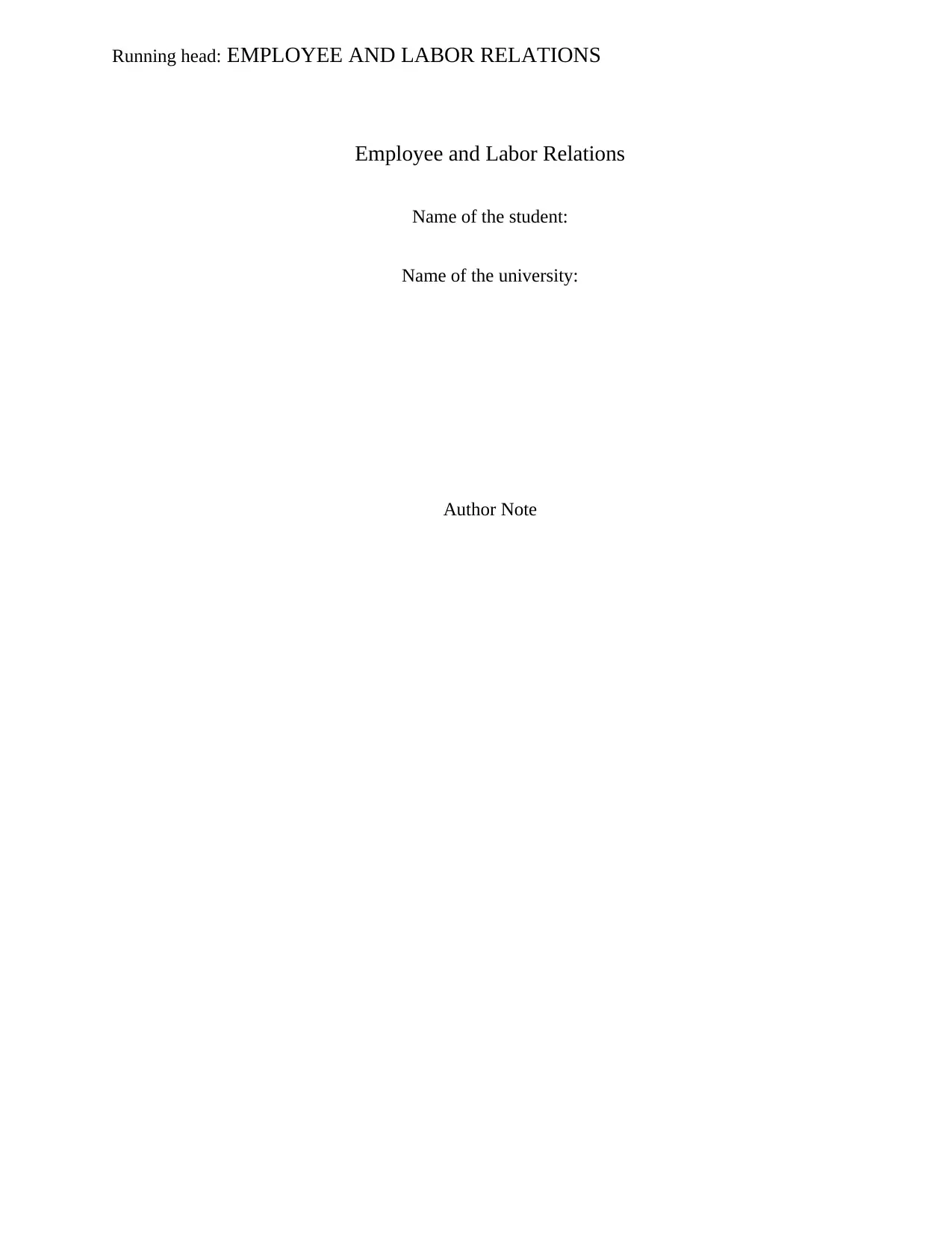
Running head: EMPLOYEE AND LABOR RELATIONS
Employee and Labor Relations
Name of the student:
Name of the university:
Author Note
Employee and Labor Relations
Name of the student:
Name of the university:
Author Note
Paraphrase This Document
Need a fresh take? Get an instant paraphrase of this document with our AI Paraphraser
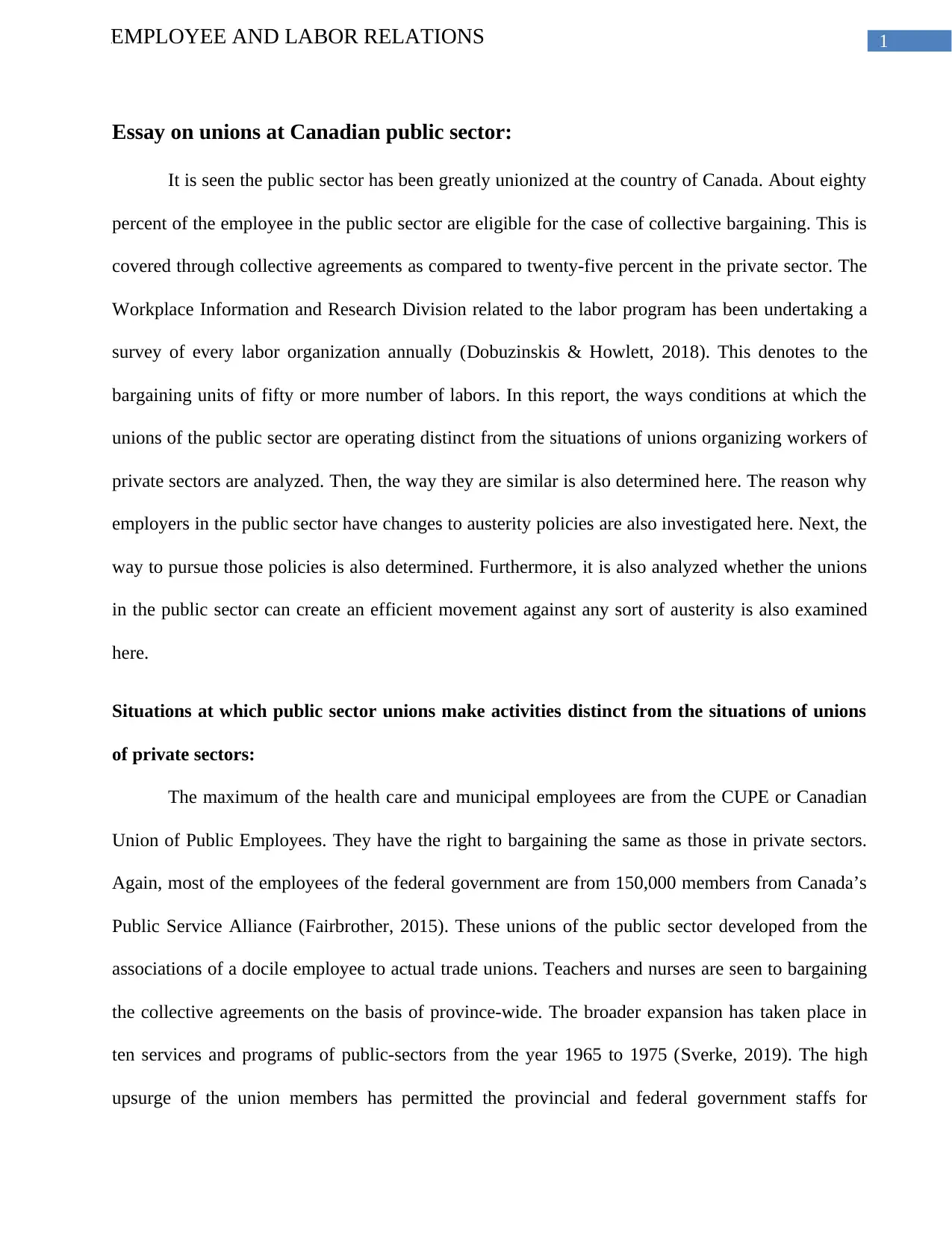
1EMPLOYEE AND LABOR RELATIONS
Essay on unions at Canadian public sector:
It is seen the public sector has been greatly unionized at the country of Canada. About eighty
percent of the employee in the public sector are eligible for the case of collective bargaining. This is
covered through collective agreements as compared to twenty-five percent in the private sector. The
Workplace Information and Research Division related to the labor program has been undertaking a
survey of every labor organization annually (Dobuzinskis & Howlett, 2018). This denotes to the
bargaining units of fifty or more number of labors. In this report, the ways conditions at which the
unions of the public sector are operating distinct from the situations of unions organizing workers of
private sectors are analyzed. Then, the way they are similar is also determined here. The reason why
employers in the public sector have changes to austerity policies are also investigated here. Next, the
way to pursue those policies is also determined. Furthermore, it is also analyzed whether the unions
in the public sector can create an efficient movement against any sort of austerity is also examined
here.
Situations at which public sector unions make activities distinct from the situations of unions
of private sectors:
The maximum of the health care and municipal employees are from the CUPE or Canadian
Union of Public Employees. They have the right to bargaining the same as those in private sectors.
Again, most of the employees of the federal government are from 150,000 members from Canada’s
Public Service Alliance (Fairbrother, 2015). These unions of the public sector developed from the
associations of a docile employee to actual trade unions. Teachers and nurses are seen to bargaining
the collective agreements on the basis of province-wide. The broader expansion has taken place in
ten services and programs of public-sectors from the year 1965 to 1975 (Sverke, 2019). The high
upsurge of the union members has permitted the provincial and federal government staffs for
Essay on unions at Canadian public sector:
It is seen the public sector has been greatly unionized at the country of Canada. About eighty
percent of the employee in the public sector are eligible for the case of collective bargaining. This is
covered through collective agreements as compared to twenty-five percent in the private sector. The
Workplace Information and Research Division related to the labor program has been undertaking a
survey of every labor organization annually (Dobuzinskis & Howlett, 2018). This denotes to the
bargaining units of fifty or more number of labors. In this report, the ways conditions at which the
unions of the public sector are operating distinct from the situations of unions organizing workers of
private sectors are analyzed. Then, the way they are similar is also determined here. The reason why
employers in the public sector have changes to austerity policies are also investigated here. Next, the
way to pursue those policies is also determined. Furthermore, it is also analyzed whether the unions
in the public sector can create an efficient movement against any sort of austerity is also examined
here.
Situations at which public sector unions make activities distinct from the situations of unions
of private sectors:
The maximum of the health care and municipal employees are from the CUPE or Canadian
Union of Public Employees. They have the right to bargaining the same as those in private sectors.
Again, most of the employees of the federal government are from 150,000 members from Canada’s
Public Service Alliance (Fairbrother, 2015). These unions of the public sector developed from the
associations of a docile employee to actual trade unions. Teachers and nurses are seen to bargaining
the collective agreements on the basis of province-wide. The broader expansion has taken place in
ten services and programs of public-sectors from the year 1965 to 1975 (Sverke, 2019). The high
upsurge of the union members has permitted the provincial and federal government staffs for
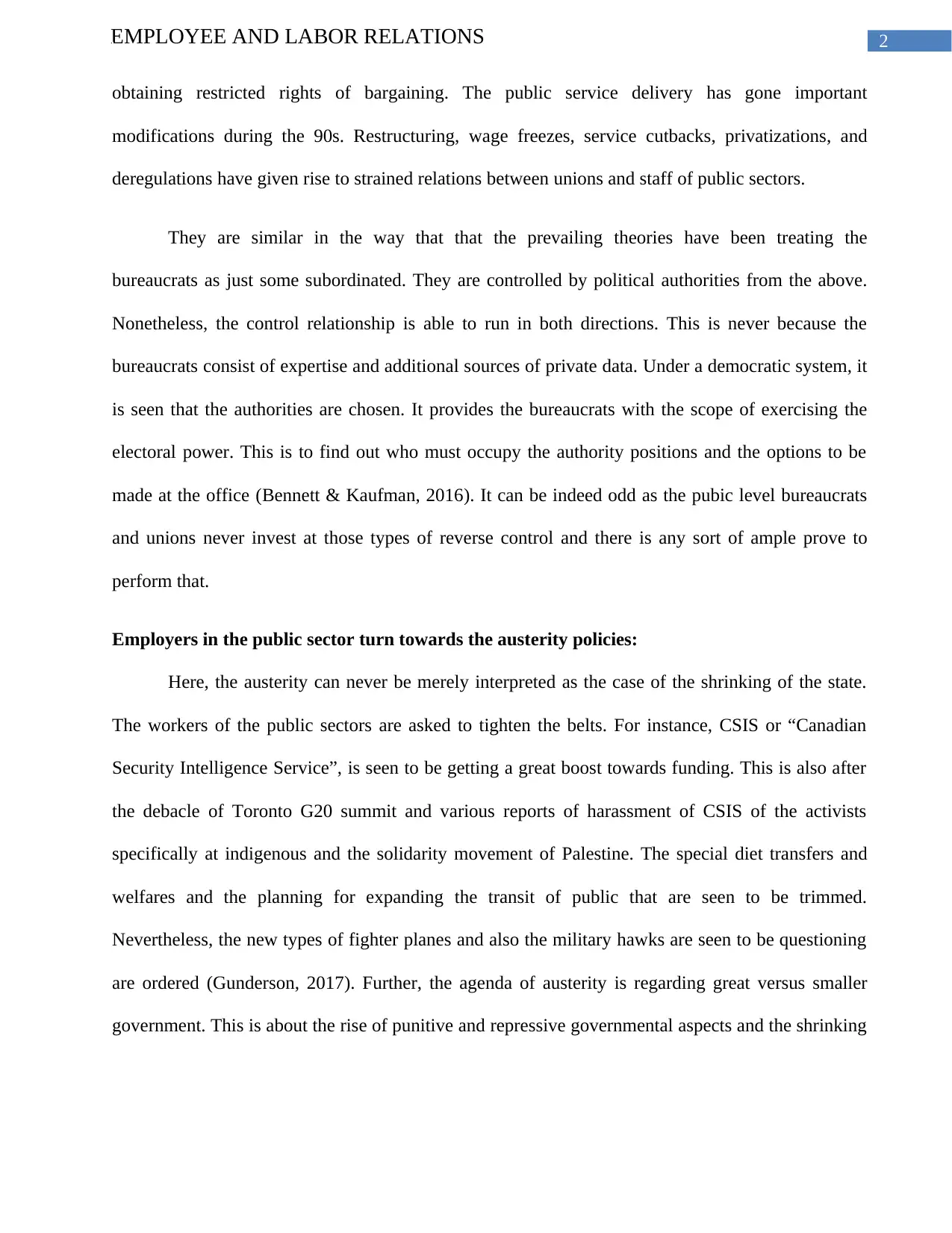
2EMPLOYEE AND LABOR RELATIONS
obtaining restricted rights of bargaining. The public service delivery has gone important
modifications during the 90s. Restructuring, wage freezes, service cutbacks, privatizations, and
deregulations have given rise to strained relations between unions and staff of public sectors.
They are similar in the way that that the prevailing theories have been treating the
bureaucrats as just some subordinated. They are controlled by political authorities from the above.
Nonetheless, the control relationship is able to run in both directions. This is never because the
bureaucrats consist of expertise and additional sources of private data. Under a democratic system, it
is seen that the authorities are chosen. It provides the bureaucrats with the scope of exercising the
electoral power. This is to find out who must occupy the authority positions and the options to be
made at the office (Bennett & Kaufman, 2016). It can be indeed odd as the pubic level bureaucrats
and unions never invest at those types of reverse control and there is any sort of ample prove to
perform that.
Employers in the public sector turn towards the austerity policies:
Here, the austerity can never be merely interpreted as the case of the shrinking of the state.
The workers of the public sectors are asked to tighten the belts. For instance, CSIS or “Canadian
Security Intelligence Service”, is seen to be getting a great boost towards funding. This is also after
the debacle of Toronto G20 summit and various reports of harassment of CSIS of the activists
specifically at indigenous and the solidarity movement of Palestine. The special diet transfers and
welfares and the planning for expanding the transit of public that are seen to be trimmed.
Nevertheless, the new types of fighter planes and also the military hawks are seen to be questioning
are ordered (Gunderson, 2017). Further, the agenda of austerity is regarding great versus smaller
government. This is about the rise of punitive and repressive governmental aspects and the shrinking
obtaining restricted rights of bargaining. The public service delivery has gone important
modifications during the 90s. Restructuring, wage freezes, service cutbacks, privatizations, and
deregulations have given rise to strained relations between unions and staff of public sectors.
They are similar in the way that that the prevailing theories have been treating the
bureaucrats as just some subordinated. They are controlled by political authorities from the above.
Nonetheless, the control relationship is able to run in both directions. This is never because the
bureaucrats consist of expertise and additional sources of private data. Under a democratic system, it
is seen that the authorities are chosen. It provides the bureaucrats with the scope of exercising the
electoral power. This is to find out who must occupy the authority positions and the options to be
made at the office (Bennett & Kaufman, 2016). It can be indeed odd as the pubic level bureaucrats
and unions never invest at those types of reverse control and there is any sort of ample prove to
perform that.
Employers in the public sector turn towards the austerity policies:
Here, the austerity can never be merely interpreted as the case of the shrinking of the state.
The workers of the public sectors are asked to tighten the belts. For instance, CSIS or “Canadian
Security Intelligence Service”, is seen to be getting a great boost towards funding. This is also after
the debacle of Toronto G20 summit and various reports of harassment of CSIS of the activists
specifically at indigenous and the solidarity movement of Palestine. The special diet transfers and
welfares and the planning for expanding the transit of public that are seen to be trimmed.
Nevertheless, the new types of fighter planes and also the military hawks are seen to be questioning
are ordered (Gunderson, 2017). Further, the agenda of austerity is regarding great versus smaller
government. This is about the rise of punitive and repressive governmental aspects and the shrinking
⊘ This is a preview!⊘
Do you want full access?
Subscribe today to unlock all pages.

Trusted by 1+ million students worldwide
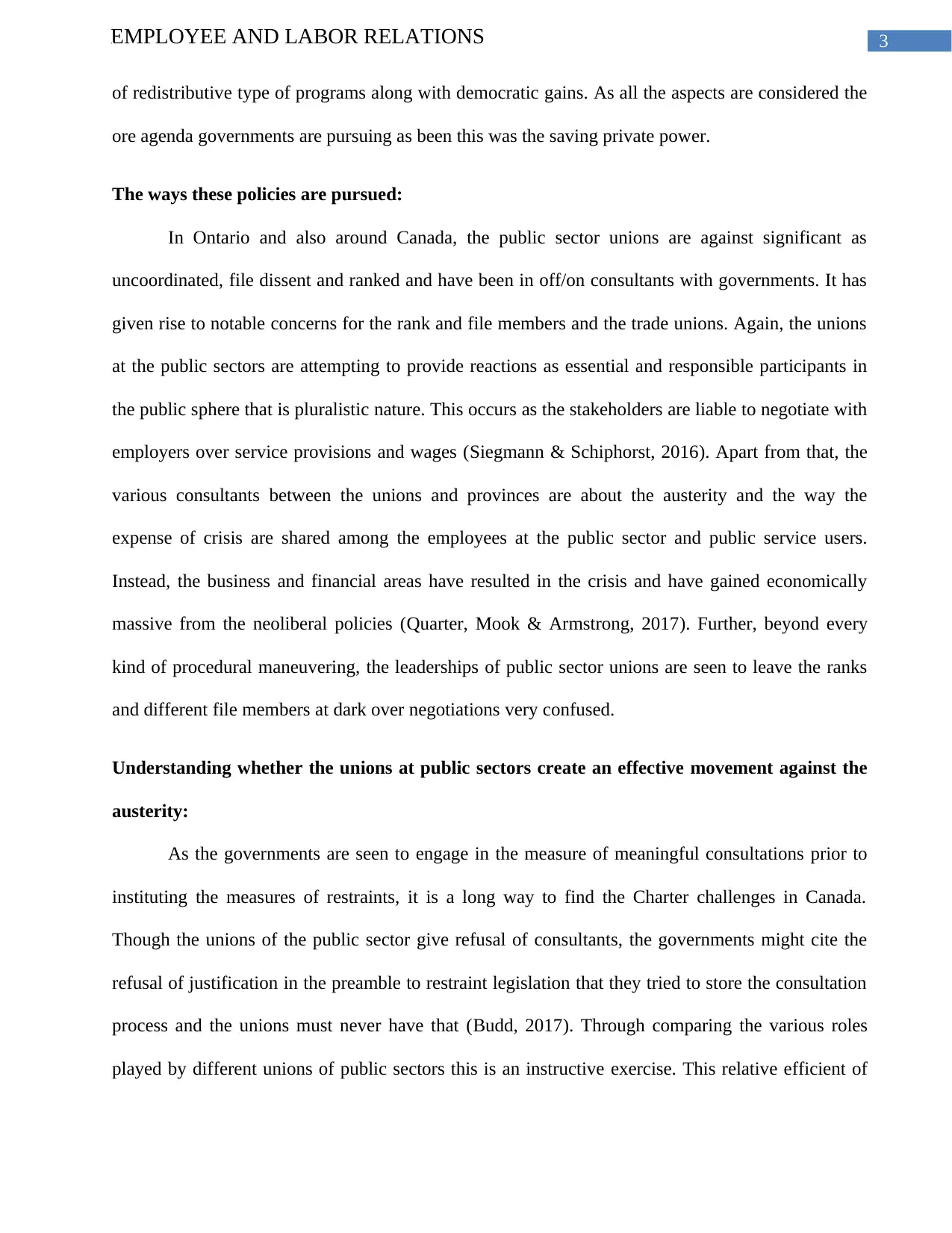
3EMPLOYEE AND LABOR RELATIONS
of redistributive type of programs along with democratic gains. As all the aspects are considered the
ore agenda governments are pursuing as been this was the saving private power.
The ways these policies are pursued:
In Ontario and also around Canada, the public sector unions are against significant as
uncoordinated, file dissent and ranked and have been in off/on consultants with governments. It has
given rise to notable concerns for the rank and file members and the trade unions. Again, the unions
at the public sectors are attempting to provide reactions as essential and responsible participants in
the public sphere that is pluralistic nature. This occurs as the stakeholders are liable to negotiate with
employers over service provisions and wages (Siegmann & Schiphorst, 2016). Apart from that, the
various consultants between the unions and provinces are about the austerity and the way the
expense of crisis are shared among the employees at the public sector and public service users.
Instead, the business and financial areas have resulted in the crisis and have gained economically
massive from the neoliberal policies (Quarter, Mook & Armstrong, 2017). Further, beyond every
kind of procedural maneuvering, the leaderships of public sector unions are seen to leave the ranks
and different file members at dark over negotiations very confused.
Understanding whether the unions at public sectors create an effective movement against the
austerity:
As the governments are seen to engage in the measure of meaningful consultations prior to
instituting the measures of restraints, it is a long way to find the Charter challenges in Canada.
Though the unions of the public sector give refusal of consultants, the governments might cite the
refusal of justification in the preamble to restraint legislation that they tried to store the consultation
process and the unions must never have that (Budd, 2017). Through comparing the various roles
played by different unions of public sectors this is an instructive exercise. This relative efficient of
of redistributive type of programs along with democratic gains. As all the aspects are considered the
ore agenda governments are pursuing as been this was the saving private power.
The ways these policies are pursued:
In Ontario and also around Canada, the public sector unions are against significant as
uncoordinated, file dissent and ranked and have been in off/on consultants with governments. It has
given rise to notable concerns for the rank and file members and the trade unions. Again, the unions
at the public sectors are attempting to provide reactions as essential and responsible participants in
the public sphere that is pluralistic nature. This occurs as the stakeholders are liable to negotiate with
employers over service provisions and wages (Siegmann & Schiphorst, 2016). Apart from that, the
various consultants between the unions and provinces are about the austerity and the way the
expense of crisis are shared among the employees at the public sector and public service users.
Instead, the business and financial areas have resulted in the crisis and have gained economically
massive from the neoliberal policies (Quarter, Mook & Armstrong, 2017). Further, beyond every
kind of procedural maneuvering, the leaderships of public sector unions are seen to leave the ranks
and different file members at dark over negotiations very confused.
Understanding whether the unions at public sectors create an effective movement against the
austerity:
As the governments are seen to engage in the measure of meaningful consultations prior to
instituting the measures of restraints, it is a long way to find the Charter challenges in Canada.
Though the unions of the public sector give refusal of consultants, the governments might cite the
refusal of justification in the preamble to restraint legislation that they tried to store the consultation
process and the unions must never have that (Budd, 2017). Through comparing the various roles
played by different unions of public sectors this is an instructive exercise. This relative efficient of
Paraphrase This Document
Need a fresh take? Get an instant paraphrase of this document with our AI Paraphraser

4EMPLOYEE AND LABOR RELATIONS
various unions are less reflective in nature. There are some professionals in public sectors and the
unions buying to legalistic ideologies of the liberal democracy and liable for trade unionism. At
present, it within the notion that this can be helpful for protecting public services (Hammer & Avgar,
2017). Nevertheless, in the case of capitalism, the formal distinction of the economic exploitations
and political relations, the political sphere is under the jurisdictions to be appearing neutral. The
consultations between the government and unions have been sustaining the appearance of neutrality.
This is the very premise of the consultants like going on to Ontario on austerity, revealing the bias in
classes of the policies of austerity that are meant for deployments. It is the case reality of trap and
law that the workers and unions are to be aware of. From the past few years, in the public sector,
there are notable strikes that are challenging and militant to the neoliberal policies. A couple of these
has ended with the back to the legislation of works (Hirsch, 2017). Again, there are lots of abilities
and also militancy across and among the public area for challenging the consultants on the austerity
in public sectors. This is possible especially as the finical crisis can take to negative turns and the
public sector workers can feel forced to the case to take to the formally illegal type of strike beyond
the demands related to a fair level of collective bargaining. It has been the case around Europe and
more than some of the precedents also in Canada.
Here, to perform the movement against austerity the initial state in developing those fight-
back has been demand the unions of public sectors keeping away from the consultants of austerity.
Next, the next step of organization mounting ad building is the fight-back is preserving bargaining
that is free collective in nature at the public sectors and the challenges of who must be paying for
that crisis. The effort can be restricted to the isolated war at just one workplace. Apart from this, it
has conflicts with every worker in public sectors (Morgan et al., 2015). Also, the managers of public
sectors that need nothing to perform the wage freeze, make the workplaces united, around areas an
around unions. Thus it is clear that any sort of anti-neoliberal type of exit to the financial crisis can
various unions are less reflective in nature. There are some professionals in public sectors and the
unions buying to legalistic ideologies of the liberal democracy and liable for trade unionism. At
present, it within the notion that this can be helpful for protecting public services (Hammer & Avgar,
2017). Nevertheless, in the case of capitalism, the formal distinction of the economic exploitations
and political relations, the political sphere is under the jurisdictions to be appearing neutral. The
consultations between the government and unions have been sustaining the appearance of neutrality.
This is the very premise of the consultants like going on to Ontario on austerity, revealing the bias in
classes of the policies of austerity that are meant for deployments. It is the case reality of trap and
law that the workers and unions are to be aware of. From the past few years, in the public sector,
there are notable strikes that are challenging and militant to the neoliberal policies. A couple of these
has ended with the back to the legislation of works (Hirsch, 2017). Again, there are lots of abilities
and also militancy across and among the public area for challenging the consultants on the austerity
in public sectors. This is possible especially as the finical crisis can take to negative turns and the
public sector workers can feel forced to the case to take to the formally illegal type of strike beyond
the demands related to a fair level of collective bargaining. It has been the case around Europe and
more than some of the precedents also in Canada.
Here, to perform the movement against austerity the initial state in developing those fight-
back has been demand the unions of public sectors keeping away from the consultants of austerity.
Next, the next step of organization mounting ad building is the fight-back is preserving bargaining
that is free collective in nature at the public sectors and the challenges of who must be paying for
that crisis. The effort can be restricted to the isolated war at just one workplace. Apart from this, it
has conflicts with every worker in public sectors (Morgan et al., 2015). Also, the managers of public
sectors that need nothing to perform the wage freeze, make the workplaces united, around areas an
around unions. Thus it is clear that any sort of anti-neoliberal type of exit to the financial crisis can
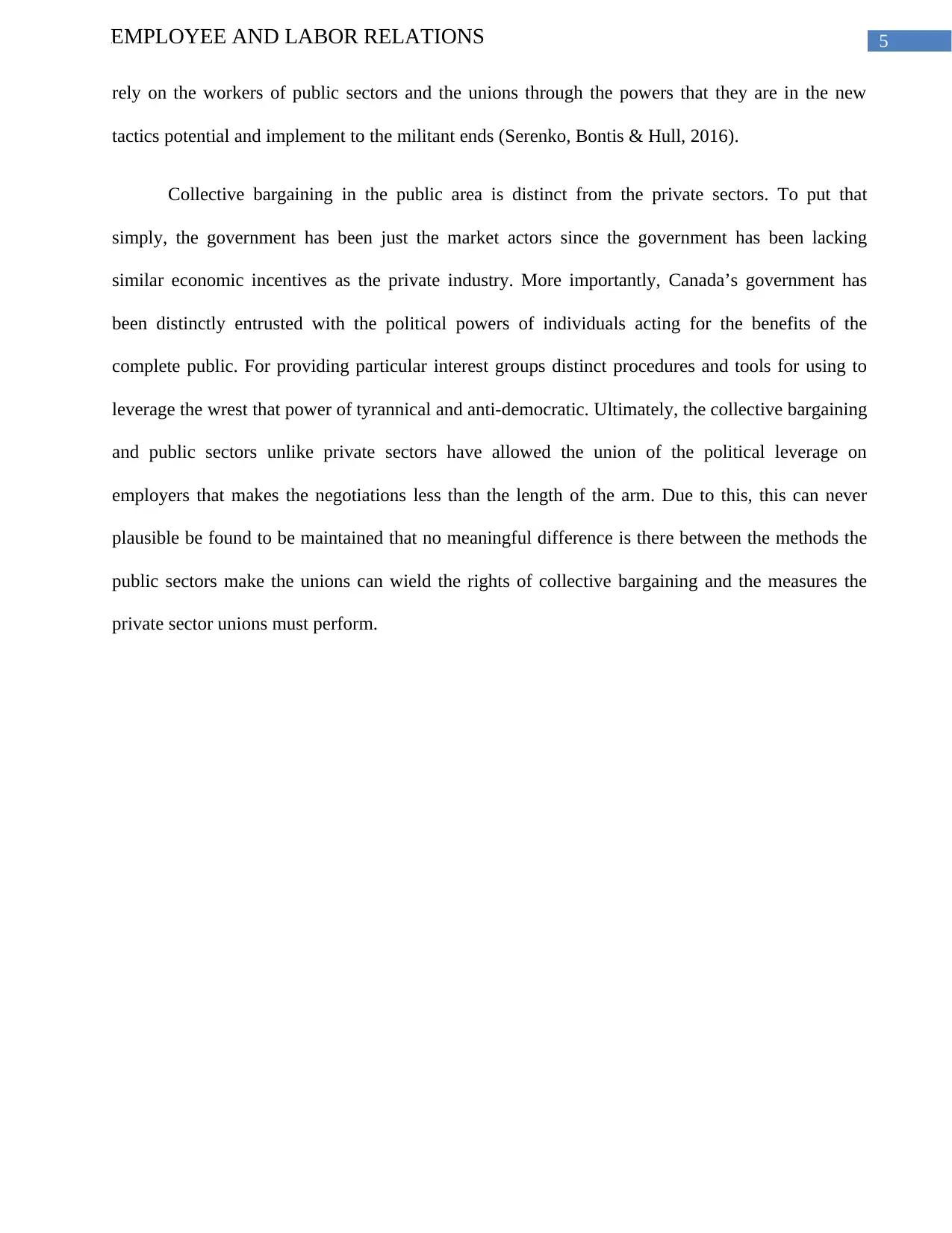
5EMPLOYEE AND LABOR RELATIONS
rely on the workers of public sectors and the unions through the powers that they are in the new
tactics potential and implement to the militant ends (Serenko, Bontis & Hull, 2016).
Collective bargaining in the public area is distinct from the private sectors. To put that
simply, the government has been just the market actors since the government has been lacking
similar economic incentives as the private industry. More importantly, Canada’s government has
been distinctly entrusted with the political powers of individuals acting for the benefits of the
complete public. For providing particular interest groups distinct procedures and tools for using to
leverage the wrest that power of tyrannical and anti-democratic. Ultimately, the collective bargaining
and public sectors unlike private sectors have allowed the union of the political leverage on
employers that makes the negotiations less than the length of the arm. Due to this, this can never
plausible be found to be maintained that no meaningful difference is there between the methods the
public sectors make the unions can wield the rights of collective bargaining and the measures the
private sector unions must perform.
rely on the workers of public sectors and the unions through the powers that they are in the new
tactics potential and implement to the militant ends (Serenko, Bontis & Hull, 2016).
Collective bargaining in the public area is distinct from the private sectors. To put that
simply, the government has been just the market actors since the government has been lacking
similar economic incentives as the private industry. More importantly, Canada’s government has
been distinctly entrusted with the political powers of individuals acting for the benefits of the
complete public. For providing particular interest groups distinct procedures and tools for using to
leverage the wrest that power of tyrannical and anti-democratic. Ultimately, the collective bargaining
and public sectors unlike private sectors have allowed the union of the political leverage on
employers that makes the negotiations less than the length of the arm. Due to this, this can never
plausible be found to be maintained that no meaningful difference is there between the methods the
public sectors make the unions can wield the rights of collective bargaining and the measures the
private sector unions must perform.
⊘ This is a preview!⊘
Do you want full access?
Subscribe today to unlock all pages.

Trusted by 1+ million students worldwide
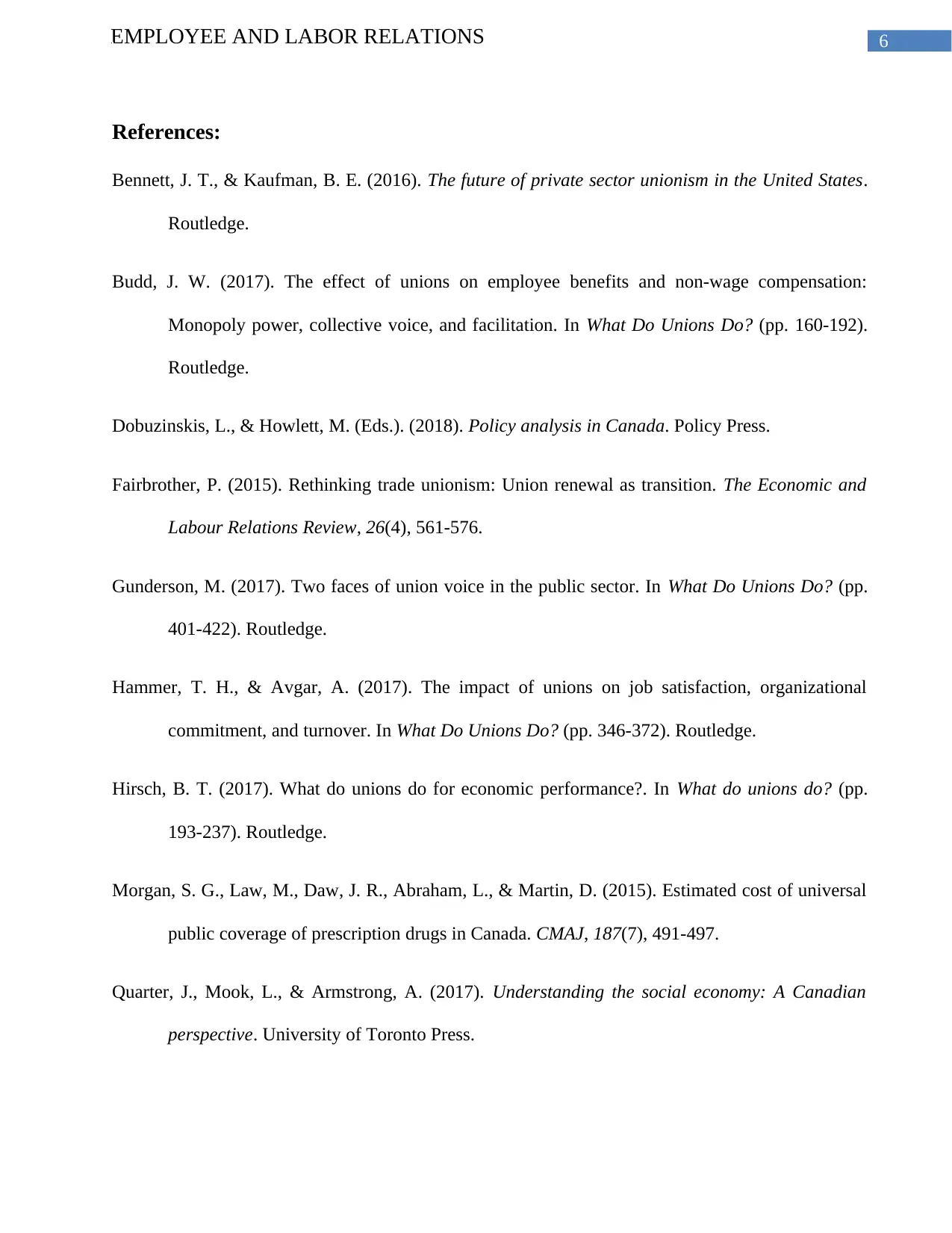
6EMPLOYEE AND LABOR RELATIONS
References:
Bennett, J. T., & Kaufman, B. E. (2016). The future of private sector unionism in the United States.
Routledge.
Budd, J. W. (2017). The effect of unions on employee benefits and non-wage compensation:
Monopoly power, collective voice, and facilitation. In What Do Unions Do? (pp. 160-192).
Routledge.
Dobuzinskis, L., & Howlett, M. (Eds.). (2018). Policy analysis in Canada. Policy Press.
Fairbrother, P. (2015). Rethinking trade unionism: Union renewal as transition. The Economic and
Labour Relations Review, 26(4), 561-576.
Gunderson, M. (2017). Two faces of union voice in the public sector. In What Do Unions Do? (pp.
401-422). Routledge.
Hammer, T. H., & Avgar, A. (2017). The impact of unions on job satisfaction, organizational
commitment, and turnover. In What Do Unions Do? (pp. 346-372). Routledge.
Hirsch, B. T. (2017). What do unions do for economic performance?. In What do unions do? (pp.
193-237). Routledge.
Morgan, S. G., Law, M., Daw, J. R., Abraham, L., & Martin, D. (2015). Estimated cost of universal
public coverage of prescription drugs in Canada. CMAJ, 187(7), 491-497.
Quarter, J., Mook, L., & Armstrong, A. (2017). Understanding the social economy: A Canadian
perspective. University of Toronto Press.
References:
Bennett, J. T., & Kaufman, B. E. (2016). The future of private sector unionism in the United States.
Routledge.
Budd, J. W. (2017). The effect of unions on employee benefits and non-wage compensation:
Monopoly power, collective voice, and facilitation. In What Do Unions Do? (pp. 160-192).
Routledge.
Dobuzinskis, L., & Howlett, M. (Eds.). (2018). Policy analysis in Canada. Policy Press.
Fairbrother, P. (2015). Rethinking trade unionism: Union renewal as transition. The Economic and
Labour Relations Review, 26(4), 561-576.
Gunderson, M. (2017). Two faces of union voice in the public sector. In What Do Unions Do? (pp.
401-422). Routledge.
Hammer, T. H., & Avgar, A. (2017). The impact of unions on job satisfaction, organizational
commitment, and turnover. In What Do Unions Do? (pp. 346-372). Routledge.
Hirsch, B. T. (2017). What do unions do for economic performance?. In What do unions do? (pp.
193-237). Routledge.
Morgan, S. G., Law, M., Daw, J. R., Abraham, L., & Martin, D. (2015). Estimated cost of universal
public coverage of prescription drugs in Canada. CMAJ, 187(7), 491-497.
Quarter, J., Mook, L., & Armstrong, A. (2017). Understanding the social economy: A Canadian
perspective. University of Toronto Press.
Paraphrase This Document
Need a fresh take? Get an instant paraphrase of this document with our AI Paraphraser
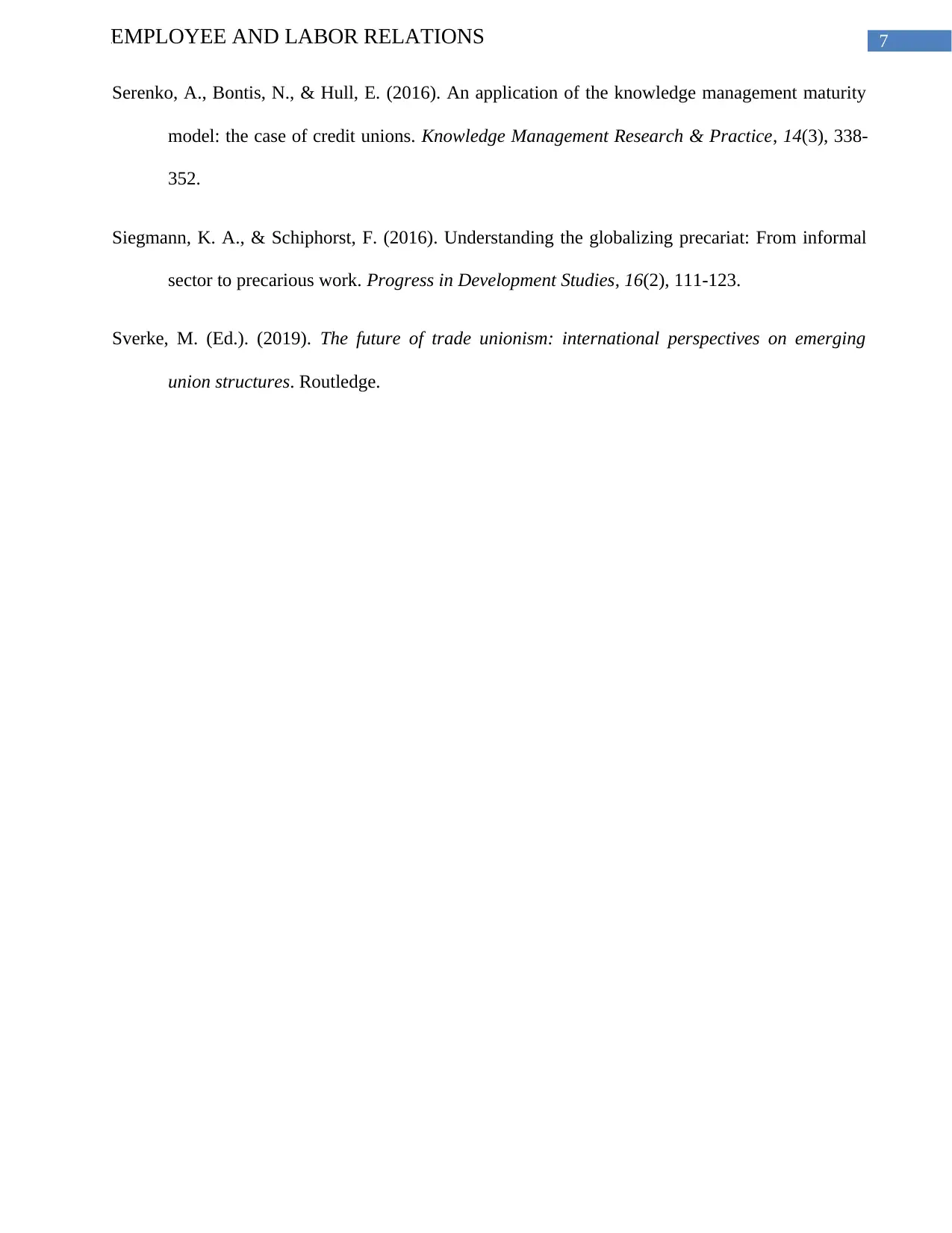
7EMPLOYEE AND LABOR RELATIONS
Serenko, A., Bontis, N., & Hull, E. (2016). An application of the knowledge management maturity
model: the case of credit unions. Knowledge Management Research & Practice, 14(3), 338-
352.
Siegmann, K. A., & Schiphorst, F. (2016). Understanding the globalizing precariat: From informal
sector to precarious work. Progress in Development Studies, 16(2), 111-123.
Sverke, M. (Ed.). (2019). The future of trade unionism: international perspectives on emerging
union structures. Routledge.
Serenko, A., Bontis, N., & Hull, E. (2016). An application of the knowledge management maturity
model: the case of credit unions. Knowledge Management Research & Practice, 14(3), 338-
352.
Siegmann, K. A., & Schiphorst, F. (2016). Understanding the globalizing precariat: From informal
sector to precarious work. Progress in Development Studies, 16(2), 111-123.
Sverke, M. (Ed.). (2019). The future of trade unionism: international perspectives on emerging
union structures. Routledge.
1 out of 8
Related Documents
Your All-in-One AI-Powered Toolkit for Academic Success.
+13062052269
info@desklib.com
Available 24*7 on WhatsApp / Email
![[object Object]](/_next/static/media/star-bottom.7253800d.svg)
Unlock your academic potential
Copyright © 2020–2025 A2Z Services. All Rights Reserved. Developed and managed by ZUCOL.





